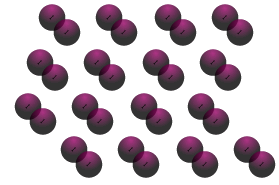|
This section explains the relationship between the possible structures adopted by the elements and their melting points. |
|
The alkali metals - metallic bonding
The group 1 elements, also known as the alkali metals are, as the name suggests, all giant metallic structures with a regular lattice of metal ions surrounded by a sea of delocalised electrons.
|
The strength of a metallic lattice is a function of:
|
In the group 1 metals the first two factors are identical for each metal, so any variation in lattice strength depends on the ionic radius of the element. The ionic radius increases in size on descending the group, weakening the metallic lattice. This may be explained in terms of the charge density of the ions decreasing as the charge/volume ratio of the ion increases, hence the delocalised electrons are less attracted to the ions.
The consequence of a weaker lattice is lower melting points, lower boiling points and softer structures (more malleable and easier to cut).
Summary of group 1
| Characteristic | Trend (descending group 1) | Reason |
| Atomic radius | Increases in size top to bottom | The number of electron shells increases from Li to Cs |
| Ionic radius | Increases from Li to Cs | The number of electron shells increases from Li to Cs |
| Electronegativity | Decreases | Attracting power of the nucleus is shielded by the inner electron shells increasingly as the group is descended |
| Ionisation energy | Decreases descending the group | Shielding effect of the inner electron shells increases as we descend the group and so the outer electron is more easily removed |
| Melting point | Decreases from Li to Cs | The larger ions cause weaker metallic bonding, as their charge density (charge/volume ratio) is lower in magnitude |
The halogens - covalent bonding
The halogens all have simple molecular structures. For this reason the lighter halogens are gases at room temperature. In the solid and liquid states the halogen structure is held together by weak dispersion forces.
 |
Example - Iodine The iodine molecules are arranged in a regular pattern, but only held together by weak dispersion forces. |
The strength of dispersion forces increases with increasing relative mass, hence the melting and boiling points of the halogens increases as the series is descended from fluorine to iodine.
Summary of group 17
| Characteristic | Trend (descending group 17) | Reason |
| Atomic radius | increases in size from F to I | The number of electron shells increases from F to I |
| Ionic radius | increases from F to I | The number of electron shells increases from F to I |
| Electronegativity | decreases | Attracting power of the nucleus is sheilded by the inner electron shells increasingly as the group is descended |
| Ionisation energy | Decreases descending the group | Shielding effect (repulsion caused by the inner electrons) of the inner electron shells increases as we descend the group and so the outer electron is more easily removed |
| Melting point | Increases from F to I | The larger halogens have greater dispersion forces holding the molecules together as they have more electrons |

